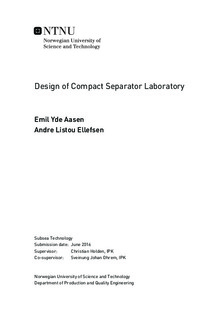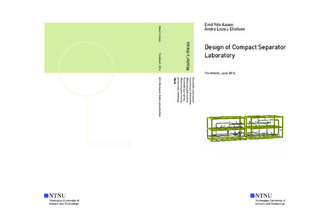| dc.description.abstract | Most of the easily accessible offshore oil and gas resources have been developed. As a result of this, subsea production and processing has over the last decade been regarded as the future of the offshore oil and gas industry. Operators are moving into more complex environments and remote locations. The increased water depths and lower temperatures implies that the existing subsea technology is in constant need of innovation.
Through the Center of Innovation-Driven Research (SFI) SUBPRO (Subsea Production and Processing), which is a cooperation between NTNU and several companies in the oil and gas industry, the industry partners expressed an interest in compact separation technology, especially hydrocyclones and Compact Flotation Units (CFUs). Since the large vessels used in conventional subsea separation technology are limited by both hydrostatic pressure and installation complexity, compact separation technology is considered a necessity for operating at greater water depths. Because of their limited volume and short residence time, compact separators are sensitive towards flow irregularities. Flow irregularities are changes in pressure and flow rate that occurs naturally in a well stream, or during start up and shut down of a well. These irregularities can potentially have a negative impact on separation efficiency. Avoiding or suppressing the effects of these flow irregularities is some of the current challenges in compact separation design.
This Master s thesis describes the design of a compact separator laboratory that will facil- itate research on novel control algorithms. The design is based on a multi-stage hydrocyclone system, with three hydrocyclones in series. The laboratory focuses on produced water treat- ment, and aims to meet the governmental regulations for disposal of produced water to the sea. By developing new aspects in control theory, the control algorithms aim to solve the problems related to flow irregularities in compact separation. As a result, the design includes several fast acting control valves, pressure- and temperature transmitters, and flow meters to provide a continuous real time overview of the system. Oil-in-Water (OiW) sensors are in- cluded to monitor the OiW concentration, and act as an input to the control system. Low shear control valves are also included in order to compare the impact on separation efficiency with conventional control valves.
The compact separator laboratory is designed and constructed through four individual phases. An additional phase, containing a feeding and reservoir system, has also been de- signed. The phases are implemented based on the experience and requirements of the previous phase/phases. The last of the four phases focuses on future solutions, and is not implemented in the budget.
The main focus of this thesis is the specific design of Phase 1, but in order to account for future expansions and increased flexibility, Phase 2, 3 and 4 are included in the design. Technical future proofing is applied in the design of Phase 1 to ease the implementation of the later phases. Phase 1 will be connected to a Cameron feeding system, with both a gravity separator and oil- and water pumps. Phase 1 is designed with EX certified components to allow testing with crude oils, which increases the credibility of the results. The additional phase, a reservoir and a feeding pump system, are designed in detail to allow fast implementation if the Cameron feeding system proves to be disadvantageous for the separation results.
The total budget for the design, construction and operation of the compact separator lab- oratory is NOK 3,000,000. The proposed design is within the budget and has an economical safety factor of 1.50 %. The health, environment and safety aspects has influenced the entire design process, and all chosen process equipment has a safety factor of 1.6 with respect to operating pressure. A NTNU standard risk assessment have been conducted. | |

